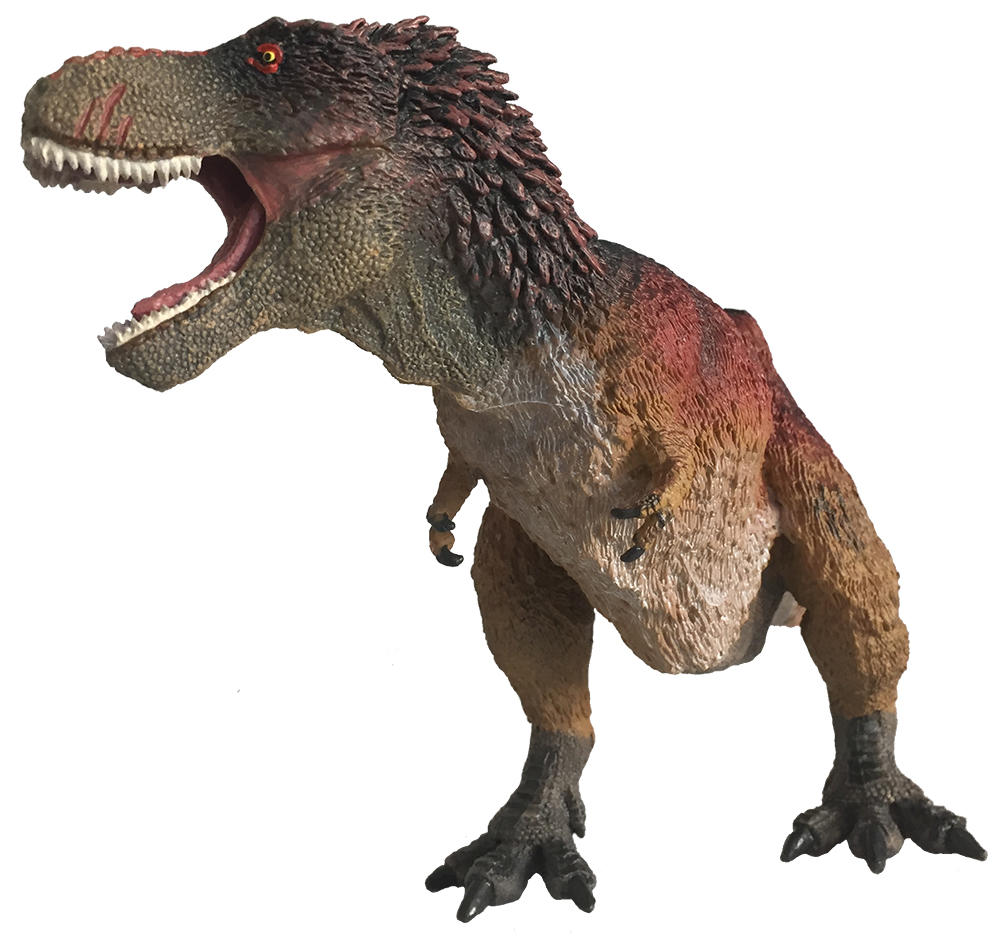Late Cretaceous (~68-66 MYA) - theropod dinosaur

Tyrannosaurus rex tooth
This cast is of a solitary Tyrannosaurus rex tooth. In life, only the smooth enamel-covered end rose above the gum line, the other two thirds remained in the jaw. Tyrannosaurus rex teeth were deeply rooted to withstand the stresses generated by large struggling prey animals.
If you compare this tooth to those of Allosaurus, it is obvious Tyrannosaurus rex was a larger theropod. However, the teeth differ not only in their size but in their design as well. While Allosaurus teeth were thin cutting blades, Tyrannosaurus rex teeth had a different design, with thick, rounded cross sections that tapered to a dull spear point. Although writers often claim T. rex teeth were sharp enough to cut your hand, they were not. You could pound this tooth into your hand to create a serious bruise or even puncture the skin, but you would not cut your flesh. The tooth’s shape reflects a different hunting approach than Allosaurus had, and the tooth design mirrored the rest of Tyrannosaurus rex’s skull. The skull of Tyrannosaurus rex was not only much larger than that of Allosaurus but had a more robust design with thick bones and smaller fenestrae that created a massive skull. One that did not give with struggling prey but overpowered them.
However, this robust design was only characteristic of adult Tyrannosaurus rexes. Young and adolescent Tyrannosaurus rex had body designs and proportions more like those of Allosaurus, with a slender body and leg proportions suited for running prey down. But as Tyrannosaurus rex approached adulthood, it transformed into another form of predator. This unusual growth pattern would be akin to a person going through the typical changes and growth spurt associated with puberty, but then at the age of twenty undergoing a second, even more extreme growth spurt. During this second growth spurt, Tyrannosaurus rex not only increased in size but acquired a far more massive build. Its head became huge and required an immense neck to carry it. Hence, its neck muscles also became huge and required muscle attachment areas that came at the expense of the animal’s arms. As a result, the arms of Tyrannosaurus rex remained the same size during this second growth spurt, becoming increasingly tiny compared to its rapidly growing body. Instead of using its arms to hunt, adult Tyrannosaurus rexes concentrated their energy into a massively powerful killing bite. Rather than slicing through flesh like a scalpel, its dull but robust teeth would indiscriminately puncture into prey and pull back to create huge gaping wounds. Tyrannosaurus rex teeth were robust enough to crush bone. Tyrannosaurus rexes had some of the most powerful bites of any known land animal in Earth’s history, only eclipsed by the giant crocodiles who shared their Cretaceous world.
However, bone studies suggest this accelerated growth came at a cost and that Tyrannosaurus rex only lived for 30 years. A ‘burn bright, burn fast’ lifestyle was appropriate for a genus that saw the end of the Mesozoic world. Tyrannosaurus rex existed at the end of the Cretaceous, 68 to 66 million years ago. Its line ended, along with three-quarters of all contemporary plant and animal species, when a large meteorite struck the Earth during a period of immense volcanism. This impact sparked a cataclysm of cascading environmental stresses that destroyed most of the existing living community and set the stage for a new radiation of life that led to our present world.
